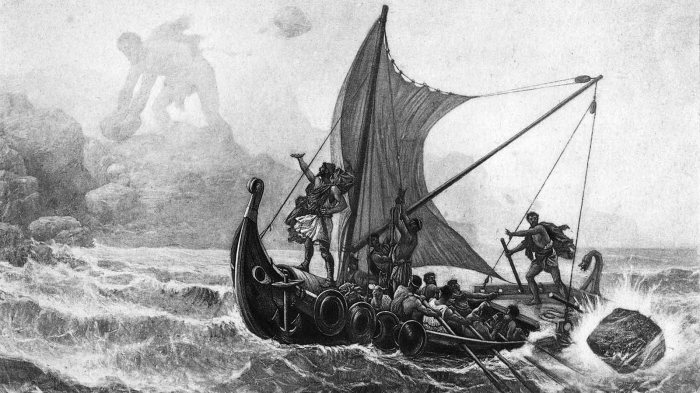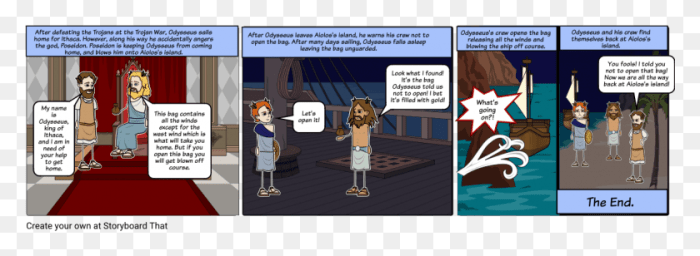Embark on the epic adventure of Odysseus and the Bag of Winds, a tale that unfolds the consequences of human curiosity and the relentless forces of nature. As Odysseus navigates the treacherous seas, a gift from the wind god Aeolus becomes both a blessing and a curse, testing the limits of his leadership and the bonds of his crew.
Follow Odysseus’ perilous journey as he grapples with the allure of forbidden knowledge and the devastating consequences that ensue, shaping the course of his destiny and leaving an indelible mark on the tapestry of Greek mythology.
Contextual Setting: Odysseus And The Bag Of Winds

Odysseus’ arduous journey home to Ithaca was fraught with challenges and adventures. One significant encounter was with Aeolus, the guardian of the winds, who played a pivotal role in Odysseus’ quest.
After enduring a tempestuous storm, Odysseus and his crew found refuge on Aeolus’ floating island. Aeolus, impressed by Odysseus’ storytelling and hospitality, gifted him with a leather bag containing all the winds except the west wind, which would propel Odysseus’ ship towards Ithaca.
The Bag of Winds

The Bag of Winds, bestowed upon Odysseus by Aeolus, the master of the winds, held a collection of powerful gusts, each with its unique characteristics and purpose. This magical artifact played a pivotal role in Odysseus’ perilous journey, providing him with the means to navigate treacherous seas and hasten his return home.
Winds Contained Within the Bag, Odysseus and the bag of winds
Within the confines of the bag, Aeolus had imprisoned four distinct winds:
- Zephyrus (West Wind):A gentle and refreshing breeze that carried ships towards the west.
- Notus (South Wind):A warm and moisture-laden wind that brought rain and storms.
- Boreas (North Wind):A cold and biting wind that caused icy conditions and hindered navigation.
- Eurus (East Wind):A strong and gusty wind that could propel ships swiftly across the seas.
Odysseus’ Use of the Bag

After receiving the bag of winds from Aeolus, Odysseus initially used it wisely to propel his ship towards Ithaca. With the winds harnessed in the bag, they sailed swiftly, aided by the favorable breezes. The journey progressed smoothly, and the crew was hopeful of reaching their destination soon.
The Consequences of Companions’ Actions
However, Odysseus’ companions, driven by curiosity or recklessness, disobeyed his explicit instructions not to open the bag. Unable to resist the temptation, they untied the strings, unleashing the powerful winds within. The sudden release of the winds caused a violent storm that tore the ship apart and scattered the crew.
Odysseus, who had been sleeping at the time, was awakened by the chaos and witnessed the devastating consequences of his companions’ actions. He was furious and deeply saddened by the loss of his crew and the setback it caused to their journey.
Symbolism and Interpretation

The bag of winds is a powerful symbol in the epic, representing both the unpredictable forces of nature and the human capacity for self-destruction.
Connection to Odysseus’ Character
Odysseus’ possession of the bag of winds highlights his hubris and overconfidence. Despite Aeolus’ warnings, Odysseus opens the bag, unleashing a storm that nearly destroys his fleet. This act reveals Odysseus’ reckless nature and his inability to control his impulses.
Significance in the Epic
The winds in the epic represent both the challenges and opportunities that Odysseus faces on his journey. The favorable winds from Aeolus initially aid Odysseus, but the destructive storm that follows becomes a major obstacle. This duality reflects the complex and often contradictory nature of life’s experiences.
Literary Impact

The bag of winds episode serves as a pivotal turning point in the Odyssey, significantly shaping the narrative’s structure and character development. It introduces a series of trials and obstacles that Odysseus must overcome, propelling the plot forward and adding depth to his character.
Narrative Structure
The episode divides the Odyssey into two distinct halves. The first half focuses on Odysseus’ journey home from Troy, while the second half centers on his struggles on Ithaca. The bag of winds episode marks the transition between these two halves, setting the stage for Odysseus’ eventual return home.
Character Development
The episode also plays a crucial role in Odysseus’ character development. It reveals his flaws and human limitations. By succumbing to the temptation to open the bag, Odysseus demonstrates his impulsivity and impatience, leading to disastrous consequences. This episode serves as a cautionary tale about the dangers of hubris and the importance of self-control.
If you’re struggling with the “unit 9 level c vocab answers,” you can find some helpful resources online. One website that provides a comprehensive list of vocabulary words and their definitions is this one . To continue our discussion about Odysseus and the bag of winds, let’s delve deeper into the consequences of his fateful decision to open it.
Comparative Analysis
The bag of winds in the Odyssey is not the only mythological object or event involving the control of winds. Other examples include:
-
-*Aiolos’s winds
In Greek mythology, Aiolos was the keeper of the winds, and he gave Odysseus a bag containing all the winds except the west wind, which was favorable for his journey.
-*Hermes’s sandals
Hermes, the messenger of the gods, wore winged sandals that allowed him to fly.
-*The chariot of Helios
Helios, the sun god, rode a chariot drawn by four horses that could fly.
These objects and events share some similarities with the bag of winds. For example, they all involve the control of winds, and they all play a significant role in the stories in which they appear. However, there are also some important differences.For
example, the bag of winds is a physical object that Odysseus can use to control the winds directly. In contrast, Aiolos’s winds, Hermes’s sandals, and the chariot of Helios are all associated with divine beings. This difference reflects the different roles that these objects play in their respective stories.The
bag of winds is a tool that Odysseus uses to help him on his journey. In contrast, Aiolos’s winds, Hermes’s sandals, and the chariot of Helios are all symbols of divine power. These objects are used to show the power of the gods and their ability to control the forces of nature.Despite
their differences, the bag of winds and other mythological objects and events involving the control of winds share a common theme: the importance of wind and its role in human affairs. Wind can be a destructive force, but it can also be a helpful one.
The bag of winds and other similar objects and events remind us of the power of wind and the importance of using it wisely.
The Bag of Winds and Aiolos’s Winds
The bag of winds and Aiolos’s winds are both examples of magical objects that can be used to control the winds. However, there are also some important differences between the two.The bag of winds is a physical object that Odysseus can use to control the winds directly.
In contrast, Aiolos’s winds are a divine force that Aiolos can control. This difference reflects the different roles that these two objects play in their respective stories.The bag of winds is a tool that Odysseus uses to help him on his journey.
In contrast, Aiolos’s winds are a symbol of divine power. Aiolos uses his winds to help Odysseus, but he also uses them to punish those who displease him.Another important difference between the bag of winds and Aiolos’s winds is the way in which they are used.
Odysseus uses the bag of winds to help him sail home to Ithaca. In contrast, Aiolos uses his winds to control the weather and to punish those who displease him.The bag of winds and Aiolos’s winds are both powerful objects, but they are used for different purposes.
The bag of winds is a tool that Odysseus uses to help him on his journey. In contrast, Aiolos’s winds are a symbol of divine power that Aiolos uses to control the weather and to punish those who displease him.
Essential FAQs
What is the significance of the Bag of Winds in Odysseus’ journey?
The Bag of Winds represents both the potential for divine assistance and the dangers of unchecked curiosity. It grants Odysseus control over the winds, but its misuse leads to disaster.
How does the episode of the Bag of Winds contribute to Odysseus’ character development?
This episode reveals Odysseus’s hubris and the consequences of his actions. It also highlights his resilience and determination in the face of adversity.
What are the symbolic meanings associated with the winds in the Bag of Winds?
The winds represent different aspects of Odysseus’s character and the challenges he faces. The North Wind symbolizes strength and determination, while the South Wind represents temptation and danger.